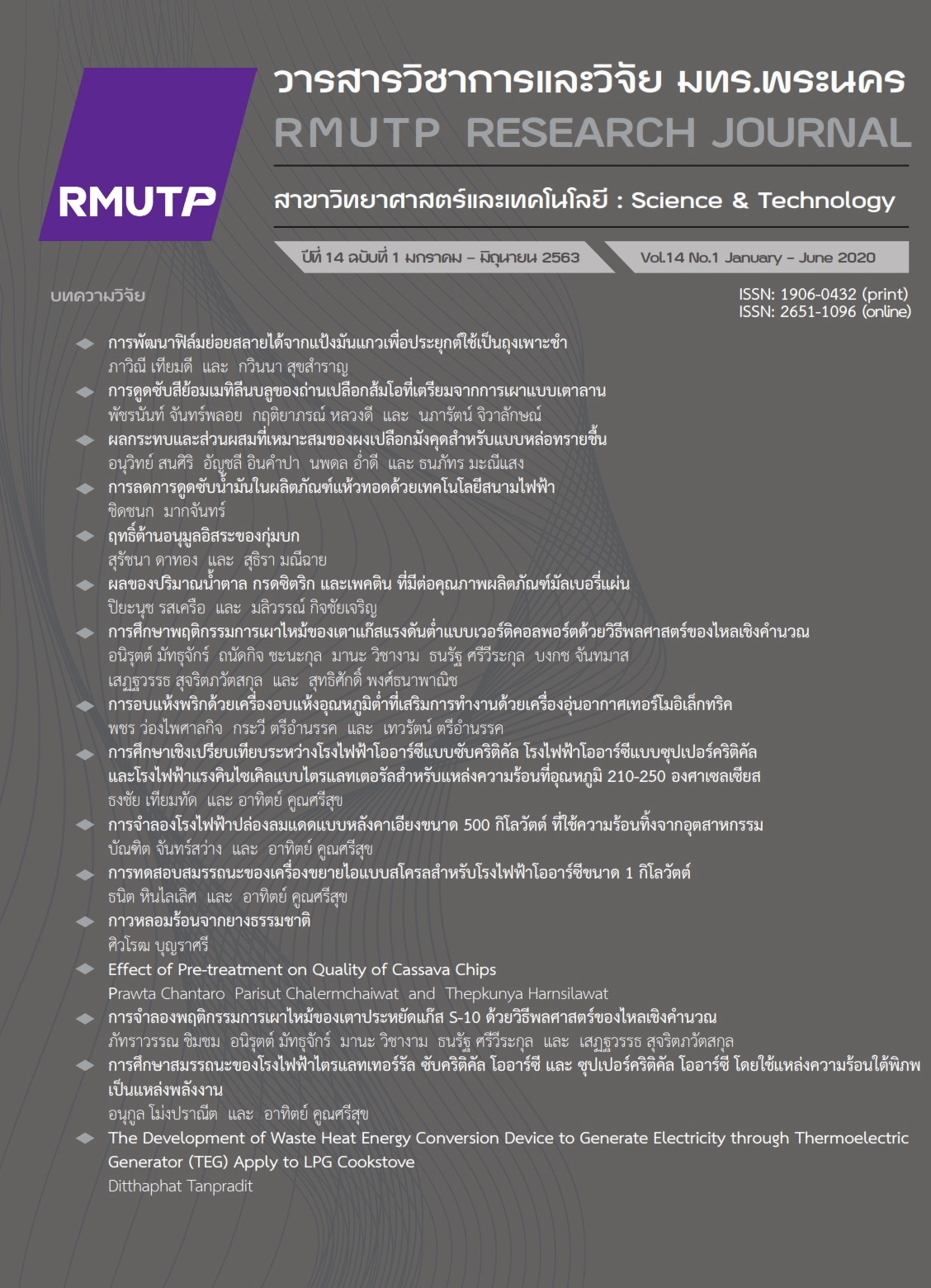Effect and Optimal Variable of Mangosteen peel powder for Green sand mold
Main Article Content
Abstract
Metal casting with Green sand mold is essential for participation in the manufacturing industry that requires natural resources and chemicals as an element. This research studied the effects of the right mix of mangosteen shell powder on green sand mold. The objective is to study and analyze the mixture of moist sand formations consisting of natural sand, bentonite, mangosteen shell powder and water affecting the properties of green sand mold by experiment method. Starting from studying relevant information of natural materials that affect sand mold and planning experimental design by using the experimental design program for the trial version in the experimental design and analyze results. The results showed that mangosteen peel powder had an effect on the properties Compression strength and higher hardness of sand mold but does not increase the ability to release a lot of air permeability The optimum blend ratio was composed of 90% reused sand, 7% bentonite, 1% water and 2% mangosteen powder by weight air permeability. The hardness of the sand casting was 0.71 kg/cm2, 47.36 and 94.06 Scale B respectively.
Article Details
References
P. Beeley, Foundry technology, 2nd ed. Oxford: Butterworth-Heinemann, 2001.
P.L. Jain, Principles of foundry technology, 5th ed. Tata McGraw-Hill Education, 2014.
R. Khuengpukheiw and Ch. Saikaew, “Effect of Molding Sand Compositions on Molding Sand Properties and Cast Iron Products,” KKU Research Journal, vol. 15, no. 4, pp. 45-61, 2015.
A.P.I. Popoola, “Effect of molasses, cassava starch, and Arabic gum on mechanical strength of foundry core,” Journal of scientific and industrial research, vol. 70, no. 12, pp. 1029-1032, Dec. 2011.
A. Islam, et al., “A review of recent developments on the regulatory, structural and functional aspects of gum Arabic,” Food Hydrocolloids, vol. 11, no. 4, pp. 493-505, 1997.
C. Bhawat, “Factors affecting strategic marketing decisions in agriculture: a study of fruit farmers in Thailand,” Ph.D. dissertation, Massey University, New Zealand, 2017.
P.Sirintorn,“(peels)Mangosteen” Department of Pharmaceutical Chemistry and Pharmacognosy faculty of Pharmaceutical Science, Naresuan University, Thailand, 2015.
Development Economic Review, vol.12 Department of Primary Industrial and mines. Ministry of industry. Thailand, 2016.
B. Pensuriya, Tannin from leaves of guava, sugar apple, Mangosteen and mangosteen peels for silk natural mordant, Bangkok: Kasetsart University Press, 2014.
Ch. Saikaew, and S. Wiengwiset, “Optimization of molding sand composition for quality improvement of iron castings,” Applied Clay Science, vol. 67-68, pp. 26-31, Oct. 2012.
Ch. Saikaew, S. Wiengwiset and A. Sriboonruang, “Improving the properties of sand molds in the iron casting industry using mixture experiments,” KKU Research Journal, vol. 16, no. 2, pp. 169-178, 2011.
S. Guharaja, A. Noorul Haq and K.M. Karuppannan, “Optimization of green sand casting process parameters by using Taguchi’s method,” The International Journal of Advanced Manufacturing Technology, vol. 30, no. 11-12, pp. 1040-1048, Feb. 2006.
R.R. Kundu and B.N. Lahiri, “Study and statistical modelling of green sand mold properties using RSM,” International Journal of Materials and Product Technology, vol. 31, no. 2/3/4, pp. 143-158, Apr. 2008.
American Foundry Society, Mold & Core Test Handbook, 4th ed., North Penny Lane Schaumburg, 2015.
W. Meethom and Ch. Rujthinnakit “Determining mixture components of sand mold by using mixture design of experiment: case study iron fitting industry,” RMUTP Research Journal, vol. 9, no. 2, pp. 74-84, Sep. 2015.


